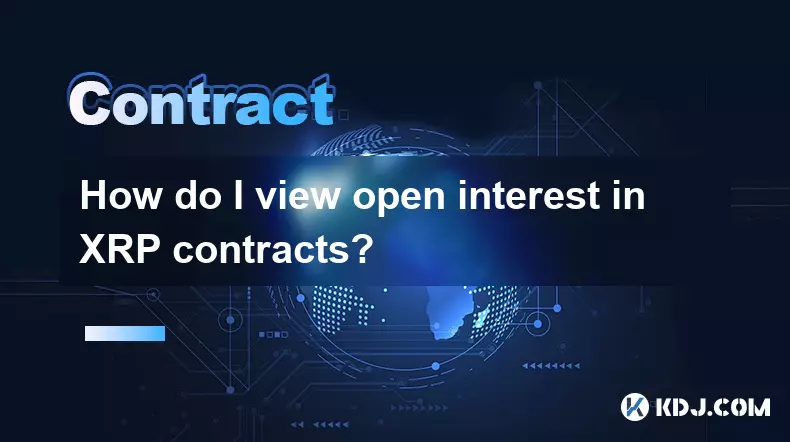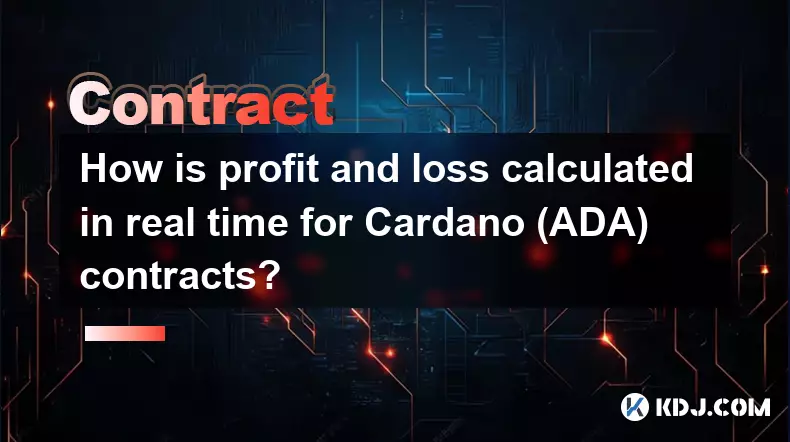-
 bitcoin
bitcoin $109667.069529 USD
-3.03% -
 ethereum
ethereum $3936.685804 USD
-4.07% -
 tether
tether $1.000493 USD
0.01% -
 xrp
xrp $2.771823 USD
-4.74% -
 bnb
bnb $957.805027 USD
-5.34% -
 solana
solana $196.735100 USD
-6.68% -
 usd-coin
usd-coin $0.999727 USD
-0.01% -
 dogecoin
dogecoin $0.227355 USD
-5.12% -
 tron
tron $0.335205 USD
-0.81% -
 cardano
cardano $0.779256 USD
-3.59% -
 ethena-usde
ethena-usde $0.999900 USD
-0.06% -
 hyperliquid
hyperliquid $42.492095 USD
-6.61% -
 chainlink
chainlink $20.501853 USD
-4.34% -
 avalanche
avalanche $28.952606 USD
-11.21% -
 stellar
stellar $0.356038 USD
-3.93%
How do I view open interest in XRP contracts?
Rising open interest in XRP futures signals new money entering the market, often confirming trend strength when aligned with price moves.
Sep 23, 2025 at 04:01 pm

Understanding Open Interest in XRP Futures
1. Open interest refers to the total number of outstanding derivative contracts, such as futures or options, that have not been settled. For XRP, this metric is crucial for traders analyzing market sentiment and potential price movements. Unlike trading volume, which resets daily, open interest accumulates over time and reflects active positions.
2. A rising open interest suggests new money entering the market, often signaling continued momentum in the current price direction. Conversely, declining open interest may indicate position closures and a potential trend reversal. Traders use this data alongside price action to assess conviction behind moves in XRP’s value.
3. Most major derivatives exchanges that list XRP futures report open interest figures directly on their platforms. These include centralized exchanges like BitMEX, OKX, and Bybit, which provide real-time dashboards displaying contract-specific metrics including funding rates, liquidations, and open interest broken down by long and short positions.
4. To access this data, navigate to the derivatives or futures section of the exchange platform. Select the XRP/USDT or XRP/USD perpetual or quarterly contract. The open interest value is typically displayed near the order book or in a dedicated statistics panel. Some platforms allow filtering by settlement currency and contract type.
5. Third-party analytics tools such as Coinglass, CryptoQuant, and Laevitas also aggregate open interest across multiple exchanges. These services offer comparative charts, historical trends, and alerts when open interest reaches predefined thresholds. They are especially useful for gaining a holistic view beyond a single exchange's data.
Data Sources for XRP Contract Analytics
1. Coinglass provides one of the most comprehensive overviews of XRP open interest, aggregating data from over ten exchanges. Users can view total open interest in USD terms, see dominance by exchange, and analyze ratios between top-tier and smaller platforms.
2. The platform breaks down long vs short positions using taker volume attribution, helping traders identify whether buying pressure comes from long liquidations or new short entries. Historical charts allow comparisons against price levels to detect divergences.
3. CryptoQuant offers on-chain insights combined with derivatives data. While its primary focus is spot market behavior, it includes futures metrics such as exchange-specific open interest and correlation analysis between reserve holdings and leverage trends involving XRP.
4. TradingView does not natively display open interest but supports community-built scripts that pull API data from exchanges. Custom indicators can overlay open interest trends on price charts, enabling technical analysts to incorporate derivatives activity into their strategies.
5. Exchange APIs, such as those provided by Bybit and OKX, allow developers to retrieve real-time open interest values programmatically. This enables integration into personal dashboards or algorithmic trading systems that react to shifts in market structure.
Interpreting Open Interest Trends in XRP Markets
1. When XRP’s price rises alongside increasing open interest, it indicates new buyers are entering, reinforcing bullish momentum. This combination is often seen during breakout phases following consolidation periods.
2. If the price increases while open interest declines, the rally may lack conviction, suggesting it’s driven by short covering rather than fresh long positions. Such rallies tend to be less sustainable.
3. A falling price with rising open interest points to aggressive new short selling, potentially leading to further downside. This scenario commonly precedes accelerated drops if margin calls trigger cascading liquidations.
4. Decreasing open interest during a downtrend signals position unwinding, possibly marking exhaustion among bears. This condition sometimes precedes reversals, particularly when accompanied by reduced trading volume.
5. Sudden spikes in open interest without significant price movement may reflect large institutional orders being placed gradually. These can foreshadow volatility once the accumulated positions begin to impact the market.
Frequently Asked Questions
What is the difference between open interest and trading volume in XRP futures?Open interest represents the total number of open derivative contracts yet to be settled, while trading volume measures the number of contracts traded within a specific timeframe. Volume resets each period; open interest persists until positions are closed.
Can open interest be used to predict XRP price direction?Open interest alone cannot predict price direction but serves as a confirmation tool. When analyzed with price trends and volume, it helps validate the strength of a move. High open interest at key price levels often marks areas of significant market attention.
Why might open interest differ between exchanges listing XRP futures?Differences arise due to varying user bases, leverage offerings, funding rate mechanisms, and regulatory restrictions. Exchanges in different jurisdictions may attract distinct types of traders—retail versus institutional—which affects positioning and overall open interest levels.
How frequently is open interest updated for XRP contracts?Most exchanges update open interest in real time, typically refreshing every few seconds. Aggregated platforms like Coinglass may have slight delays depending on API response times but generally reflect conditions within one minute of changes.
Disclaimer:info@kdj.com
The information provided is not trading advice. kdj.com does not assume any responsibility for any investments made based on the information provided in this article. Cryptocurrencies are highly volatile and it is highly recommended that you invest with caution after thorough research!
If you believe that the content used on this website infringes your copyright, please contact us immediately (info@kdj.com) and we will delete it promptly.
- Bitcoin Crash Watch: Glassnode Signals Potential Cooling Phase
- 2025-09-26 20:25:12
- Bitcoin's Slow Grind: Is the Crypto Market Primed for a Burst?
- 2025-09-26 20:25:12
- BePay, Bitcoin Rewards, and Web3 Investments: A New Era in Dubai
- 2025-09-26 20:30:01
- Spinning Wheels, Fundraisers, and Crypto Traction: What's the Connection?
- 2025-09-26 20:30:01
- Cryptos to Watch: BlockchainFX, Remittix, and the Meme Coin Mania
- 2025-09-26 20:30:01
- Euro Stablecoin, Banks, and the BEST Wallet Token: A New Era for Digital Finance?
- 2025-09-26 20:30:15
Related knowledge

How do I enable the "scalping-only" mode for Cardano (ADA) contracts?
Sep 24,2025 at 03:19am
Understanding Scalping Strategies in Crypto Derivatives1. Scalping in cryptocurrency trading refers to executing multiple short-term trades within min...

What is the maximum position limit for Cardano (ADA) contracts?
Sep 23,2025 at 11:00pm
Understanding ADA Futures and Derivatives Market Structure1. Cardano (ADA) futures contracts are offered by several major cryptocurrency derivatives e...

What is the maker fee for Cardano (ADA) contracts?
Sep 26,2025 at 09:01am
Understanding Maker Fees in Cardano (ADA) Contracts1. The concept of maker fees applies broadly across decentralized exchanges and smart contract plat...

How can I view open interest in Cardano (ADA) contracts?
Sep 24,2025 at 07:36am
Understanding Open Interest in Cardano Derivatives1. Open interest refers to the total number of outstanding derivative contracts, such as futures or ...

What is the function of the insurance fund in Cardano (ADA) contracts?
Sep 24,2025 at 02:18am
Understanding the Role of Insurance Funds in Cardano Smart Contracts1. The insurance fund within Cardano's ecosystem is not a native feature directly ...

How is profit and loss calculated in real time for Cardano (ADA) contracts?
Sep 26,2025 at 04:18pm
Understanding Real-Time Profit and Loss in Cardano (ADA) Contracts1. Real-time profit and loss (P&L) calculations for Cardano-based smart contracts re...

How do I enable the "scalping-only" mode for Cardano (ADA) contracts?
Sep 24,2025 at 03:19am
Understanding Scalping Strategies in Crypto Derivatives1. Scalping in cryptocurrency trading refers to executing multiple short-term trades within min...

What is the maximum position limit for Cardano (ADA) contracts?
Sep 23,2025 at 11:00pm
Understanding ADA Futures and Derivatives Market Structure1. Cardano (ADA) futures contracts are offered by several major cryptocurrency derivatives e...

What is the maker fee for Cardano (ADA) contracts?
Sep 26,2025 at 09:01am
Understanding Maker Fees in Cardano (ADA) Contracts1. The concept of maker fees applies broadly across decentralized exchanges and smart contract plat...

How can I view open interest in Cardano (ADA) contracts?
Sep 24,2025 at 07:36am
Understanding Open Interest in Cardano Derivatives1. Open interest refers to the total number of outstanding derivative contracts, such as futures or ...

What is the function of the insurance fund in Cardano (ADA) contracts?
Sep 24,2025 at 02:18am
Understanding the Role of Insurance Funds in Cardano Smart Contracts1. The insurance fund within Cardano's ecosystem is not a native feature directly ...

How is profit and loss calculated in real time for Cardano (ADA) contracts?
Sep 26,2025 at 04:18pm
Understanding Real-Time Profit and Loss in Cardano (ADA) Contracts1. Real-time profit and loss (P&L) calculations for Cardano-based smart contracts re...
See all articles










































































